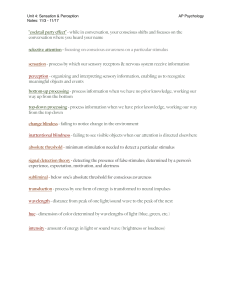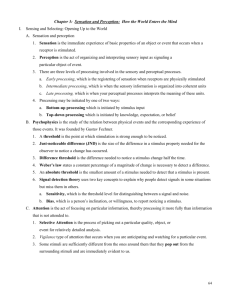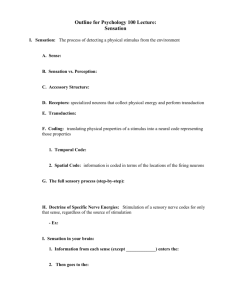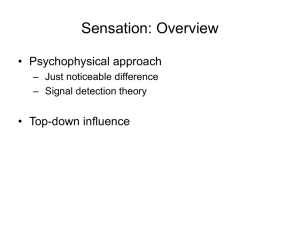Ch.4 AP Psych
advertisement
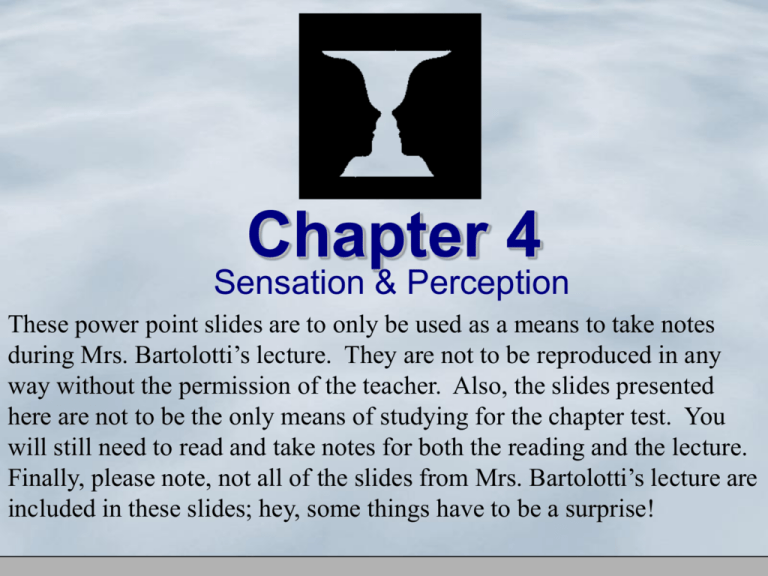
Chapter 4 Sensation & Perception These power point slides are to only be used as a means to take notes during Mrs. Bartolotti’s lecture. They are not to be reproduced in any way without the permission of the teacher. Also, the slides presented here are not to be the only means of studying for the chapter test. You will still need to read and take notes for both the reading and the lecture. Finally, please note, not all of the slides from Mrs. Bartolotti’s lecture are included in these slides; hey, some things have to be a surprise! Sensation and Perception Sensation – An early stage of perception in which neurons in a receptor create an internal pattern of nerve impulses that represent the conditions that stimulated it – either inside or outside the body Perception – A process that makes sensory patterns meaningful and more elaborate How Does Stimulation Become Sensation? The brain senses the world indirectly because the sense organs convert stimulation into the language of the nervous system: neural impulses Transduction Transduction – Transformation of one form of energy into another – especially the transformation of stimulus information into nerve impulses Receptors – Specialized neurons that are activated by stimulation and transduce (convert) it into a nerve impulse Stimulation Transduction Sensation Perception Transduction Sensory pathway – Bundles of neurons that carry information from the sense organs to the brain Sensory Adaptation Sensory adaptation – Loss of responsiveness in receptor cells after stimulation has remained unchanged for a while Thresholds Absolute threshold – p.114 table 4.1 The minimum amount of stimulation required in order for a stimulus to be detected. Difference threshold – Smallest amount by which a stimulus can be changed and the difference be detected 50 percent of the time (also called just noticeable difference – JND) Thresholds Weber’s law – (Ernest Weber) (ever notice how commercials are always louder than the show you were just watching?) The principle that, to perceive their difference, two stimuli must differ by a constant % (rather than by a constant amount) • The size of the JND is proportional to the intensity of the stimulus – so, the JND is large when the stimulus intensity is high, and the JND is small when the stimulus intensity is low. • 2 lights must differ by 8% in intensity • 2 objects by 2% in intensity • 2 tones by .03% Thresholds – Weber’s In Real Life • This also parallels some of our life experiences. If the price of a .50 cent candy bar goes up .05 cents, shoppers would probably notice it; similarly, if the cost of a $50,000 Mercedes goes up $5,000, potential buyers would raise an eyebrow. In both cases, the price went up by 10%; our thresholds for detecting differences are a roughly constant proportion of the original stimulus. Signal Detection Theory Signal detection theory – Assumes there is no single absolute threshold and that detection depends on perceptual judgment as a combination of sensation and decision-making processes. Noise in the dark Stimulus event RAS alerts your brain – NOISE! Neural activity Have I heard that before? It’s a cat on the roof; no need to get up. Comparison with personal standard Action (or no action) Subliminal Persuasion Studies have found that subliminal words flashed briefly on a screen can “prime” a person’s later responses No controlled research has ever shown that subliminal messages delivered to a mass audience can influence people’s buying habits How Are the Senses Alike? How Are They Different? The senses all operate in much the same way, but each extracts different information and sends it to its own specialized processing region in the brain The Anatomy of Visual Sensation Retina – Light-sensitive layer at the back of the eyeball Photoreceptors – Light-sensitive cells in the retina that convert light energy to neural impulses Rods – Sensitive to dim light but not colors Cones – Sensitive to colors but not dim light Fovea – Area of sharpest vision in the retina Afterimages – What happens when retina is fatigued? • If you fatigue the cells in the retina, it will cause an effect known as an “afterimage.” These are sensations that linger after the stimulus is removed. • Positive afterimages are caused by a continuation of the receptor and neural processes following stimulation (e.g. seeing the flash of a light bulb after it goes off; sparklers on 4th of July. • Negative afterimages are caused by the opposite or the reverse of the original stimulus. This is best explained by the Opponent Process Theory of Color. • Opponent Process Theory of Color states that when you are seeing one color, you are suppressing or inhibiting the opposite color from being seen (e.g. sensing red, not sensing green; sensing blue, not sensing yellow; sensing black, not sensing white). Colors come in OPPOSITE pairs. The Anatomy of Visual Sensation Optic nerve – Bundle of neurons that carries visual information from the retina to the brain Blind spot – Point where the optic nerve exits the eye and where there are no photoreceptors Transduction of Light in the Retina The Anatomy of Visual Sensation Visual cortex – Part of the brain – the occipital cortex – where visual sensations are processed Color – Psychological sensation derived from the wavelength of visible light – color, itself, is not a property of the external world Neural Pathways in the Human Visual System How the Visual System Creates Color Electromagnetic spectrum – Entire range of electromagnetic energy, including radio waves, X-rays, microwaves, and visible light Visible spectrum – Tiny part of the electromagnetic spectrum to which our eyes are sensitive How the Visual System Creates Color Copyright © Allyn and Bacon 2006 The Ways of Sensing Colors •Trichromatic Theory: The earliest stage of color sensation that states that colors are sensed by three different types of cones sensitive to light in the red, blue, and green wavelengths. Color Blindness Color blindness – Vision disorder that prevents an individual from discriminating certain colors Hearing: If a Tree Falls in the Forest... The Physics of Sound Frequency – Number of cycles completed by a wave in a given amount of time Low Frequency High Frequency Hearing: If a Tree Falls in the Forest... The Physics of Sound Amplitude – Physical strength of a wave High Amplitude Low Amplitude How Sound Waves Become Auditory Sensations Tympanic membrane – The eardrum How Sound Waves Become Auditory Sensations Cochlea – Where sound waves are transduced How Sound Waves Become Auditory Sensations Cochlea Basilar membrane – Thin strip of tissue sensitive to vibrations How Sound Waves Become Auditory Sensations Auditory nerve – Neural pathway connecting the ear and the brain How Sound Waves Become Auditory Sensations Auditory cortex – Portion of the temporal lobe that processes sounds The Psychology of Pitch, Loudness, and Timbre Pitch – Sensory characteristic of sound produced by the frequency of the sound wave (place theory and frequency theory) Loudness – Sensory characteristic of sound produced by the amplitude (intensity) of the sound wave Timbre – The quality of the sound wave that comes from both pitch and loudness (mom’s voice vs. Mrs. B’s voice). Deafness Conduction deafness – An inability to hear resulting from damage to structures of the middle or inner ear Nerve deafness – An inability to hear, linked to a deficit in the body’s ability to transmit impulses from the cochlea to the brain, usually involving the auditory nerve or higher auditory processing centers Position and Movement Vestibular sense – Sense of body orientation with respect to gravity Kinesthetic sense – Sense of body position and movement of body parts relative to each other How Do You Smell? (haha) Olfaction – Sense of smell Olfactory bulbs – Brain sites of olfactory processing Pheromones – Chemical signals released by organisms to communicate with other members of the species Taste Gustation – The sense of taste Taste buds – Receptors for taste (primarily on the upper side of the tongue) The Skin Senses • Touch • Warmth • Cold • All skin senses are registered in the somatosensory cortex of the parietal lobe. Pain •Pain is psychological, not physical! •Gate Control Theory – Close the gate on the sensation that gets to the brain that way I won’t feel the pain! Placebos – Substances that appear to be drugs but are not Placebo effect – A response to a placebo caused by subjects’ belief that they are taking real drugs What is the Relationship Between Perception and Sensation? Perception brings meaning to sensation, so perception produces an interpretation of the external world, not a perfect representation of it The Machinery of Perceptual Processing Percept – Meaningful product of a perception Feature detectors – Cells in the cortex that specialize in extracting certain features of a stimulus Binding problem – A major unsolved mystery in cognitive psychology, concerning the physical processes used by the brain to combine many aspects of sensation to a single percept Bottom-Up and Top-Down Processing Bottom-up processing – Analysis that emphasizes characteristics of the stimulus, rather than internal concepts Top-down processing – Emphasizes perceiver's expectations, memories, and other cognitive factors Perceptual Constancies Perceptual constancy – Ability to recognize the same object under different conditions, such as changes in illumination, distance, or location Perceptual Ambiguity and Distortion Illusions – Demonstrably incorrect experience of a stimulus pattern, shared by others in the same perceptual environment Ambiguous figures – Images that are capable of more than one interpretation Perceptual Illusions Do you see or ? Perceptual Illusions The Herman Grid Do you see small gray squares between the black squares? Theoretical Explanations for Perception Learning-based inference – View that perception is primarily shaped by learning, rather than innate factors Perceptual set – Readiness to detect a particular stimulus in a given context Some illusions are learned! Here is what you are seeing The Gestalt Approach Gestalt psychology – View that much of perception is shaped by innate factors built into the brain Figure – Part of a pattern that commands attention Ground – Part of a pattern that does not command attention; the background The Gestalt Approach Subjective contours – Boundaries that are perceived but do not appear in the stimulus pattern Copyright © Allyn and Bacon 2006 The Gestalt Approach Closure – Tendency to fill in gaps in figures and see incomplete figures as complete The Gestalt Laws of Perceptual Grouping Similarity Proximity Continuity Common fate Prägnanz Law of Prägnanz A BIRD IN THE THE HAND How do we perceive depth? The Visual Cliff How do we perceive depth? Monocular Cues – Depth cues that do not depend on having two eyes. Binocular Cues – Depth cues that depend on having both eyes. End of Chapter 4

